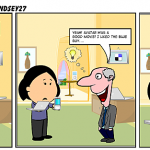In activity 2, you were exposed to commercial softwares and their open source, freeware and cloud-based equivalents. Provide a brief review any of the software that you tried from that list that may be unfamiliar to the class.
Well, I am not sure if they are unfamiliar to the class as people are at different levels in their courses/background experience etc. But I am excited to share the ones I have used anyway!
Gimp – really awesome! It was fun to play with the graphics/manipulate them etc. It took some time to learn how to use the program, but then it was easy!
Audacity – really great for recording your own voice! I am currently using it in my moodle course I am creating for 565
NVU – user friendly, and also a few tutorials out there on YouTube to get you started! Really great
Picasa – neat product that allows you to upload photos to the web and share. This is great if you want to add photos to a website or google maps (as I just found out!)
IrfanView – fabulous for cutting down the size of pictures for websites
IWisoft Flash SWF to Video – great product to convert SWF files to something that can play on your computer (WMV etc)
Jing – very cool product that records or takes still images of your computer screen. Excellent for adding images to a website or providing a great how to video!
This is the list off the top of my head. I will try to think of more!
Based on the information provided in activity 3, please explain which platform, Apple or PC or other you would choose for setting up a lab at your school or institution and why.
That is a tough question! I think it depends on what the district and school decide. Perhaps they have a contract with one or the other (my school is PC)
I think I would go PC because of the teaching staff. They are slightly (in the most respectful way) resistant to change. If we introduced Apple they would flip out. Like in the example on voice thread when trying to change from office to open source!
The PC/Apple debate rages on…some will ask “well wouldn’t you want to do what’s best for the students” I think that either apple or PC will provide students with all they need. Plus, with many open source products available you do not necessarily have to use the “i” product. Thus I think it would be good for both students and staff to have a PC lab.
Now if only we could actually get one!
From what we have seen in previous learning modules, most of us are philosophically aligned with open source. But from our case studies, we have seen how difficult it has been for many open source projects to gain widespread acceptance. We would like the class to discuss creative ways in which we can help encourage the use of open source software. Of course, if you disagree with the point, we encourage you to share your thoughts as well.
Please identify the factors that have prevented you from using Open Source technologies in your classroom or school. How have you been able to overcome these challenges?
The major factor that prevents my school is knowledge. They just don’t know it’s out there. I was talking to our tech guy about moodle and it being open source etc and he had never heard of it!
So I think integration would be more likely if teachers and administration knew more about it.
Then I think it would be time. Teachers need time to play around with new equipment. It is unrealistic to tell a teacher to integrate something they don’t understand or can show others how to use!
Thus, we need more pro D regarding open source programs with time for teachers to master them before placing them in the classroom.
Referencing the technologies listed on the Classroom Economics page or other Educational Technology tools that you’d like to discuss, please explain which of these are worth investing in and which are not?
For example: Is buying a Smartboard a worthwhile expenditure for your classroom or are there better ways to spend the same money?
I think it depends on how much money you have!!
I think if people really understood the capabilities of the smartboard it is a great choice. But, I fear that most people use it as a glorified projector.
However, I think tablets would be where I would spend the money…interactive and promotes constructivism!
It’s apparent that through technology, classrooms will be transformed over the next decade (adoption of open-source, choice with operating systems, new technologies, e-textbooks, privatization, immersive 3-D learning environments). In your opinion, are these innovations being driven to fuel learning or are they being pursued to reduce the costs? Or both? Will technology reduce the need for teachers? Are you optimistic about what lies ahead for educators?
I am optimistic only because of MET. Otherwise I would be a little worried! When we don’t understand something we tend to be cautious, timid, or sometimes we lash out. Thus, because of my (i’d say novice) understanding I feel better about what lies ahead. I feel like I can be someone who helps make the change instead of sitting back and watching it happen feeling helpless.
But in regards to innovations I think it is two-fold – we always consider the best learning outcome for the lowest price. That is part of working in a business. School, we can’t forget, has some business aspects to it. Therefore, i think it’s both!
yay for optimism!


